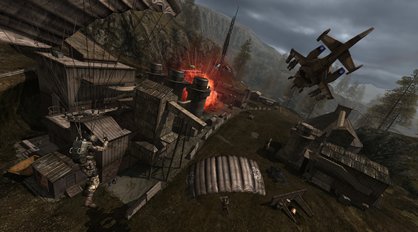Enemy Territory: Quake Wars - dev commentary
We talk Strogg with Splash Damage
Sandbox gameplay
Wedgwood: “Sandboxes are fun - but they’re more about the introduction of rules to gameplay, otherwise it’s just a kick about in the park rather than a proper football match. But with Quake Wars we realised that you can’t be too constraining with your toolset, and have to make it intuitive or people won’t find it fun.
“We had a massive advantage because of the progression of objectives through ET:QW’s maps. What that meant was that you had this naturally shifting frontline, and people understood when an objective was completed.
“As an attacker, you get this feeling of progress with stuff being built and so on, while the defending team get this feeling of having lost territory and being pushed backwards. However, both teams still know where the frontline is, so that as a player you can choose to head straight there but have a shorter life span, or you can skirt around the frontline to outflank the enemy, and get into fighting with vehicles.”

RPG elements
Wedgwood: “I think Wolfenstein: Enemy Territory was the first multiplayer shooter that when you played online you got promotions according to your rank, and you could unlock attribute modifiers to your character.
“From the very beginning in ET:QW we really wanted to make your status persistent, and so in the original game design, we kept the idea of gameplay rewards through a campaign, but they would then reset after that so you’d get a level playing field. You didn’t go online and find that because someone had been playing for months they had a rocket launcher or something and the game was completely unbalanced. Instead we reset the gameplay rewards, but your status as a player was reflected persistently. I think that’s worked out really well, going by the number of people that play on the ranked servers compared to the unranked servers.”
Weekly digests, tales from the communities you love, and more
Balance of power
Wedgwood: “We had four approaches for feedback which worked well for Quake Wars. At the really hardcore end of it, we hired eight production testers from ex-professional gaming teams and high-level clans, who focused on really hardcore specifics, such as ‘Is this window sill one pixel too high?’ Then we’d have less hardcore, more analytical matches between us, id and Activision, plus our QA team at Activision would work 24 hours a day tracking down bugs. Finally, we had the community, with about 2,000 people initially in a closed beta, opening up to 60,000 for a public beta to capture things like crash reports from different hardware setups.
“There was a real balancing challenge with two asymmetric teams in the game - there’s no easy way to directly correlate a GDF medic’s ability to revive someone on the battlefield versus a Strogg technician’s ability to create a spawn host for a teammate to spawn into. So we just argued a lot really...”


